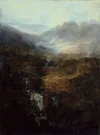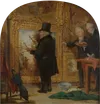In 1750 France opened the first painting gallery in the Palais du Luxembourg. The British Museum followed in 1759 and in 1779 the Fridericianum, Germany’s first museum. Prior to that, art was only on show to the public in churches and on public squares. As of the mid-18th-century, in the course of the Enlightenment rulers gradually made their collections accessible to the public. In 1793, at the time of the French Revolution, the Louvre was opened as the ‘central art museum of the Republic’. Napoleon had all the artworks looted throughout Europe presented in the Louvre so as to demonstrate France’s superiority. The artworks were elucidated by means of explanations, guided tours and cheap catalogues. Thus the art museum as we know it today was born.
In the early 19th century numerous civil-society initiatives followed aimed at setting up societies and clubs. The Kunstgesellschaft Luzern, for example, was founded in 1819 with the aim of compiling a picture archive for the general public. To this very day, that society is responsible for the Kunstmuseum Luzern.

















































